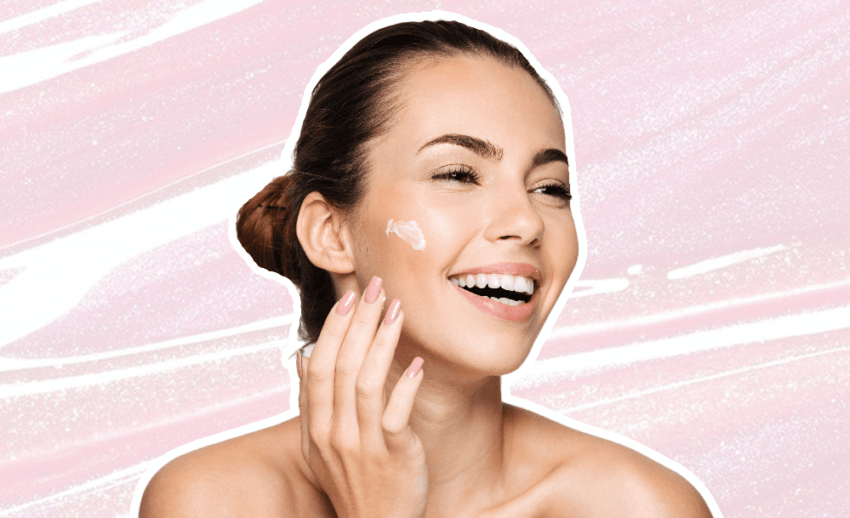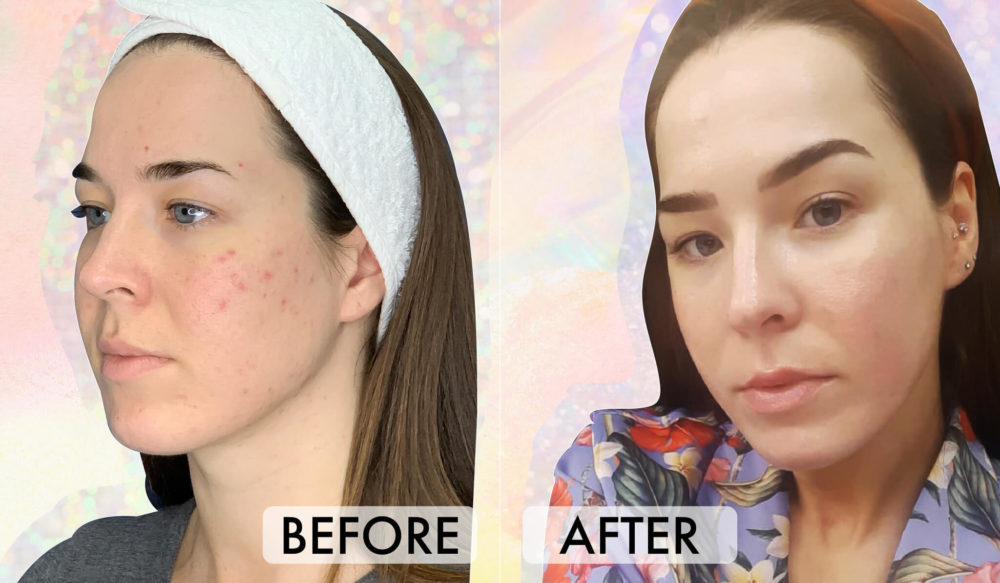The Ultimate (Derm-Approved) Routine For Oily Skin

If you’re a regular on Huda Beauty, you’ll know just how life-changing it can be to build a regime that perfectly suits your skin type. Oily skin is a prime example of this: you need to know the correct formulas, ingredients, and products to avoid shine and keep breakouts at bay. We reached out to some of the world’s leading dermatologists; Dr. Dennis Gross, Founder of the Dr. Dennis Gross skincare line, Dr.Timm Goueleke creator of skincare brand Royal Fern and Founder of the Dr. Golüke Clinic in Munich, plus Dr.Friedmann, a leading dermatologist at The Harley Street Dermatology Clinic. So basically, your skin is in safe hands. But before we outline the perfect regime, you need to understand the characteristics and properties of oily skin:
What it looks like: Typically, oily skin has larger visible pores and you’ll be more prone to blackheads, whiteheads, and pimples – you’ll know all about the midday shine.
Why its oily: Our body naturally produces oil called sebum, which keeps our skin soft and supple. However, the more sebum our body produces, the bigger the oil glands get, which increases the size of our pores… meanwhile, all that excess oil created sits on the surface of the skin. Oily skin can be hereditary, but it can also be a result of a hormone change triggered by your period, pregnancy or as a result of lifestyle choices.
The Ultimate Routine For Oily Skin:
Step 1: Cleanse every morning and night
 via Giphy
via Giphy
Dr. Friedmann insists that the first step to a good regime is “gentle cleansing, both in the morning and evening, as it’ll relieve oiliness.” Although, in the evening we like to go the extra mile and double cleanse: It’s our fave K-Beauty trick and will work wonders on oily skin, as by cleansing twice (with an oil and then a foam or gel) you’ll ensure that all the dirt, oil, and dead skin is properly removed.
Morning: Start your morning routine with a gel or foam cleanser. Gel formulas are perfect for oily skin as they help decongest clogged pores and remove excess oil without stripping or dehydrating the skin. Look for formulas that have antibacterial ingredients as this will help combat any acne bacteria in the skin. We love the Mario Badescu Enzyme Cleansing Gel, $14, it contains natural exfoliants papaya and grapefruit, which will prevent build-up that can cause blackheads and pimples.
Evening: Start by cleansing with a cleansing oil, which will remove SPF, makeup, and sebum. Look for an oil with anti-inflammatory and anti-bacterial ingredients like tea tree or witch hazel. Check out the Shu Uemura Anti/Oxi+ Pollutant & Dullness Clarifying Cleansing Oil, $40, which is packed with green tea and antioxidants. Follow your oil cleanse with a gel or foam cleanser, which will remove any traces of makeup and clean deep into your pores – be sure to massage the cleanser into your skin for at least one minute. Dr. Dennis Gross recommends the Alpha Beta Pore Perfecting Cleansing Gel, $38, as it contains Barosma betulina leaf extract, which will reduce and refine pores by balancing sebaceous secretion while limiting the amount of oil produced.
Step 2: Tone
 via Giphy
via Giphy
Toning is an integral step in all skincare regimes as it helps restore the skin’s pH balance, which will help control oil production. A good toner will tighten your pores, making them appear smaller while also removing any impurities lying on the surface of the skin. If your toner contains AHAs or BHAs it can help to clean deeper into the pores and get rid of any dirt or toxins. If you have oily skin you should also look for natural ingredients like chamomile, rose or ginseng to tighten your skin and reduce inflammation.
Morning: Ease your skin into the day by using a soothing toner, as you don’t want to overwhelm your skin with too many harsh ingredients. Look for a toner that contains hydrating ingredients like aloe vera, ginseng, or hyaluronic acid. We love the Kiehl’s Cucumber Herbal Alcohol-Free Toner, $16, it naturally rebalances your skin with herbal extracts, leaving skin feeling toned and clean.
Evening: This is when you need a more potent toner to help tighten your pores and remove excess oil as well as any pollution your skin has tackled throughout the day. Use a toner that contains AHAs, as these will penetrate deep into your pores. We’re currently using the pre-soaked, COSRX One Step Original Clear Pad, $19, which are formulated with willow bark extract, Tea Tree, and hyaluronic, so they’ll exfoliate while simultaneously hydrating your skin – it’s a win-win!
Step 3: Don’t skip the moisturizer!
 via Giphy
via Giphy
A lot of people with oily skin don’t moisturize as they assume that moisturizing will make their skin even greasier, but if your skin is dehydrated it can actually produce more oil. So, by using a moisturizer it will help to rebalance moisture levels and oil production. Look for gel moisturizers that have a water-like texture and are super lightweight, as these contain the lowest amount of oil, waxes, and emulsifiers. Also check to see if they’re non-comedogenic, which means they won’t clog pores.
Morning: In the morning use a lightweight formula or a serum. Serums are crazy hydrating and packed with active ingredients but they don’t feel heavy on your skin. Everyone’s skin is different, even those with oily skin, so we recommend a little testing: try a few days just using a serum and see if it helps lower oil levels – if you feel like you need more moisture, then test using a lightweight moisturizer, like the Tarte Drink of H20 moisturizing formula, $39, which is infused with marine extracts to hydrate and nourish the skin. For serums, we like the Clinique Moisture Surge Hydrating Supercharged Concentrate, $39, as it contains super hydrating but non oily, hyaluronic acid, and we LOVE the Dr. Jart Cicapair Tiger Grass Re.Pair Serum, $46, as it features one of our fave ingredients Centella Asiatic (find out why we love it here).
Evening: In the evening, you can afford to use a heavier cream (you don’t have to worry about midnight shine), as this is when your skin loses the most moisture and does all its repairing. The All-In-One Snail Repair Cream, $19, is formulated with a 92% snail extract (we know it sounds gross) that helps heal acne marks and hydrate the skin without being too heavy.
Tip: Skip the face oil! If there’s one skincare step you can afford to skip, it’s a facial oil. Dr. Timm Goueleke warns against them stating “rich face oils and essential oils will plug your pores” ultimately leading to breakouts. Dr. Dennis Gross agrees stating that in general, “you should look for oil-free products and stay clear of products with natural oils – adding these to an already oily skin type can result in clogged pores and breakouts.”
Posts You'll Love:
Daytime Essential: Never forget SPF
 via Giphy
via Giphy
We can’t stress how important it is to use SPF on a daily basis. Sun damage is one of the main contributors to skin damage such as fine lines, wrinkles, dark spots, and hyperpigmentation. And although you may think that slapping on a thick sunscreen is going to wreak havoc on your skin, it’ll actually help soften the appearance of acne scars and hyperpigmentation, which if left unprotected, won’t be able to fade.
Look for a lightweight sunscreen with SPF 30 and a 5-star UVA-rating for the summer months, and then a product containing SPF during the winter. We love the Thank You Farmer Sun Project Water Sun Cream SPF50+, $24, as it offers great protection and doesn’t feel greasy or sticky on your skin – it also works really nicely under makeup. Remember, sunscreen is the final step in your skincare routine before your primer or makeup.
Nighttime Essential: Use a retinol
 via Giphy
via Giphy
Although the prospect of using a retinol may scare some, oily skin actually tolerates retinol the best. Dermatologists swear by retinol and insist that you should incorporate retinol into your routine from as early on as your 20s. Retinol is a form of vitamin A, which thickens the deeper layer of your skin, smooths out wrinkles by increasing collagen production and helps control oil production, tightening pores and improving acne-prone skin.
Retinol should only be used at night and needs to be introduced into your regime slowly. Start using it two or three times a week for the first month (it can make skin dry at first, so decrease use if this happens), and as your skin gets used to it, you can increase to nightly use. We recommend the Philosophy Help Me, $49.00, as it’s amazing at decongesting pores – use under your moisturizer for the best results. If you’re not ready to splash the cash, we love The Inkey List’s Retinol, $13, which has 1% retinol, and 0.5% granactive retinoid (retinol’s slightly stronger sibling), and squalane for soothing.
Extra Steps:
Step 1: Exfoliate using a chemical exfoliator
 via Giphy
via Giphy
Exfoliation should be an essential step in all beauty routines, but if you have oily skin it’s a must as it’ll help remove any dirt, debris or dead skin blocking your pores. Although Dr. Dennis Gross insists that you should “avoid harsh scrubs and over-drying skin as this will result in your skin increasing its own natural production of oil to compensate for the dryness caused by products, further exasperating the problem.”
Instead, opt for a chemical exfoliator, which is an enzyme or acid-based formula that penetrates deep into the skin, dissolving and dislodging dead skin. Dr. Dennis Gross recommends salicylic acid as a must-have ingredient for oily skin, “It’s oil soluble so it’s able to deeply penetrate and unclog oil-ridden pores.” It’s also anti-inflammatory and antibacterial so it’ll help stamp out any acne bacteria in the skin.
We’re obsessed with the Bliss That’s Incredi-peel, $22, spa-strength glycolic resurfacing pads to smooth and brighten, which we like to use two or three times a week. We also love the cult classic, Sand and Sky Flash Perfection Exfoliating Treatment, $49, although as this has mechanical exfoliators as well as AHAs you only need to use this once or twice a week, and you don’t need to use it in conjunction with other exfoliators or you run the risk of over-exfoliating. Be careful when you’re applying the treatment not to rub too hard, as this could damage your skin.
Step 2: Use a purifying mask
 via Giphy
via Giphy
Face masks are one of the most underused products, not because we don’t love them, but because most of us view masks as a weekly or fortnightly activity, when in fact you can use them every day. Of course, if you use the same mask every day, it may overwhelm your skin, so we like to mask three times a week, alternating between soothing masks, extracting masks, purifying masks, and hydrating masks.
For oily skin, we recommend doing at least two masks a week – one soothing mask and one detoxifying mask. More specifically a detoxifying clay mask, as clay has antiseptic and astringent properties, which will help remove oil from your pores. Dr. Dennis recommends the Clarifying Colloidal Sulfur Mask, $32, which contains sulfur and kaolin clay that’ll absorb oil and fight acne-inducing bacteria. We also love L’Oréal’s Clay mask range, which has five different masks to cater to different skin concerns, read our full review here.
To soothe and hydrate the skin, we use the Indie Lee Clearing mask, $60, which contains salicylic and glycolic acids that exfoliate, while bentonite clay and colloidal sulfur to help gently draw out impurities.
Do a weekly steam
Dr. Dennis Gross insists that if you have “oily skin and large pores, which are prone to surface build-up, steaming is one of the best, most natural ways to clean and hydrate simultaneously. The steam works to heat up the skin and causes waxy solid buildup to liquefy and drain out of the pore. This process removes dirt, bacteria and makeup residue that can lead to acne.” You can either buy a steamer like the Dr. Dennis Gross Pro Facial Steam, $149, that uses “micro-steam technology to infuse skin with hydration, clarify the complexion and detoxify skin.” Or you can do a DIY facial steam (find out how to give yourself a DIY facial steam here). We recommend doing a weekly steam, especially during the winter months – it helps to clean out your sinuses too, which is kinda gross but totally necessary.
Extra tips for keeping oily skin in check:
- Blotting sheets: Trust us, if you have oily skin, then blotting sheets are your best friend. They absorb any oil sitting on your skin within seconds. We never leave the house without the Boscia Green Tea Blotting Linens, $10, which contain soothing green tea extract and antioxidant-rich Jojoba.
- Watch your diet: We recently spoke to nutritionist Dr. Oz Garcia who gives celebs like Naomi Campbell and Gwyneth Paltrow their nutrition plans. He told us to “Avoid dairy as it’s an inflammatory, which can trigger acne because it promotes redness and swelling.” The main culprit is the milk proteins in cow’s milk, which have been shown to trigger breakouts; instead, try to substitute it with almond or coconut milk. However, Dr. Oz said there are some dairy exceptions: “Plain Greek yogurt or kefir are rich in probiotics that contain healthy bacteria to fight inflammation and promote better skin.”
- Use hyaluronic acid after your toner: For an extra hit of hydration, we like to use a hyaluronic acid, like The Ordinary’s Hyaluronic Acid 2% + B5, $11, as it helps your skin retain moisture (not oil), to rebalance your skin.
- Try niacinamide: Niacinamide, aka vitamin B3, isn’t just an anti-aging miracle, it also helps to control oil production, thereby decreasing pore size. As an added bonus, it also helps even skin tone, brighten the complexion and strengthen the skin barrier. Check out The Ordinary’s Niacinamide 10% + Zinc 1%, $10, which you can apply after toner and before a serum or moisturizer.
Let us know if you all have any other skin concerns that you need help with, in the comments below.























Leave a comment